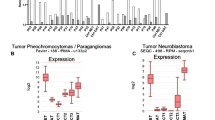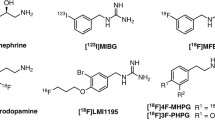Abstract
Objectives
Small animal imaging with meta-iodobenzylguanidine (MIBG) allows characterization of animal models, optimization of tumor treatment strategies, and monitoring of gene expression. Anesthetic agents, however, can affect norepinephrine (NE) transport and systemic sympathetic activity. We thus elucidated the effects of anesthetic agents on MIBG transport and biodistribution.
Methods
SK-N-SH neuroblastoma and PC-12 pheochromocytoma cells were measured for 123I-MIBG uptake after treatment with ketamine (Ke), xylazine (Xy), Ke/Xy, or pentobarbital (Pb). NE transporters were assessed by Western blots. Normal ICR mice and PC-12 tumor-bearing mice were injected with 123I-MIBG 10 min after anesthesia with Ke/Xy, Ke, Xy, or Pb. Plasma NE levels and MIBG biodistribution were assessed.
Results
Cellular 123I-MIBG uptake was dose-dependently inhibited by Ke and Xy but not by Pb. Treatment for 2 h with 300 μM Ke, Xy, and Ke/Xy decreased uptake to 46.0 ± 1.6, 24.8 ± 1.5, and 18.3 ± 1.6% of controls. This effect was completely reversed by fresh media, and there was no change in NE transporter levels. In contrast, mice anesthetized with Ke/Xy showed no decrease of MIBG uptake in target organs. Instead, uptakes and organ-to-blood ratios were increased in the heart, lung, liver, and adrenals. Plasma NE was notably reduced in the animals with corresponding decreases in blood MIBG, which partly contributed to the increase in target organ uptake.
Conclusion
In spite of their inhibitory effect at the transporter level, Ke/Xy anesthesia is a satisfactory method for MIBG imaging that allows favorable target tissue uptake and contrast by reducing circulating NE and MIBG.






Similar content being viewed by others
References
Lee KH, Ko BH, Paik JY, Jung KH, Choe YS, Choi Y, et al. Effects of anesthetic agents and fasting duration on 18F-FDG biodistribution and insulin levels in tumor-bearing mice. J Nucl Med 2005;46:1531–6.
Fueger BJ, Czernin J, Hildebrandt I, Tran C, Halpern BS, Stout D, et al. Impact of animal handling on the results of 18F-FDG PET studies in mice. J Nucl Med 2006;47:999–1006.
Accorsi R, Morowitz MJ, Charron M, Maris JM. Pinhole imaging of 131I-metaiodobenzylguanidine (131I-MIBG) in an animal model of neuroblastoma. Pediatr Radiol 2003;33:688–92.
Rutgers M, Buitenhuis CK, van der Valk MA. [131I]-and [125I] metaiodobenzylguanidine therapy in macroscopic and microscopic tumors: a comparative study in SK-N-SH human neuroblastoma and PC12 rat pheochromocytoma xenografts. Int J Cancer 2000;90:312–25.
Rutgers M, Buitenhuis CK, Hoefnagel CA. Targeting of meta-iodobenzylguanidine to SK-N-SH human neuroblastoma xenografts: tissue distribution, metabolism and therapeutic efficacy. Int J Cancer 2000;87:412–22.
Anton M, Wagner B, Haubner R, Bodenstein C, Essien BE, Bonisch H, et al. Use of the norepinephrine transporter as a reporter gene for non-invasive imaging of genetically modified cells. J Gene Med 2004;6:119–26.
Moroz MA, Serganova I, Zanzonico P, Ageyeva L, Beresten T, Dyomina E, et al. Imaging hNET reporter gene expression with 124I-MIBG. Nucl Med 2007;48:827–36.
Nishimura M, Sato K, Okada T. Ketamine inhibits monoamine transporters expressed in human embryonic kidney 293 cells. Anesthesiology 1998;88:768–74.
Hara K, Yanagihara N, Minami K. Ketamine interacts with the noradrenaline transporter at a site partly overlapping the desipramine binding site. Naunyn Schmiedebergs Arch Pharmacol 1998;358:328–33.
Shahani SK, Lingamaneni R, Hemmings HC Jr. General anesthetic actions on norepinephrine, dopamine, and gamma-aminobutyric acid transporters in stably transfected cells. Anesth Analg 2002;95:893–9.
Salt PJ, Barnes PK, Beswick FJ. Inhibition of neuronal and extraneuronal uptake of noradrenaline by ketamine in the isolated perfused rat heart. Br J Anaesth 1979;51:835–8.
Maignan E, Dong WX, Legrand M. Sympathetic activity in the rat: effects of anaesthesia on noradrenaline kinetics. J Auton Nerv Syst 2000;80:46–51.
Matsukawa K, Ninomiya I, Nishiura N. Effects of anesthesia on cardiac and renal sympathetic nerve activities and plasma catecholamines. Am J Physiol 1994;265:R792–7.
Appel E, Dudziak R, Palm D, Wnuk A. Sympathoneuronal and sympathoadrenal activation during ketamine anesthesia. Eur J Clin Pharmacol 1979;16:91–5.
Franks NP, Lieb WR. Molecular and cellular mechanisms of general anaesthesia. Nature 1994;367:607–14.
Kaka JS, Hayton WL. Pharmacokinetics of ketamine and two metabolites in the dog. J Pharmacokinet Biopharm 1980;8:193–202.
Rector E, Otto K, Kietzmann M, Nolte I, Lehmacher W. Pharmacokinetics and effects of xylazine (Rompun) in dogs. Berl Munch Tierarztl Wochenschr 1996;109:18–22.
Shouda S, Kurata C, Mikami T, Wakabayashi Y. Effects of extrinsically elevated plasma norepinephrine concentration on myocardial 123I-MIBG kinetics in rats. J Nucl Med 1999;40:2088–93.
Burchardi H, Kaczmarczyk G. The effect of anaesthesia on renal function. Eur J Anaesthesiol 1994;11:163–8.
Ambrisko TD, Hikasa Y. Neurohormonal and metabolic effects of medetomidine compared with xylazine in beagle dogs. Can J Vet Res 2002;66:42–9.
Ho CM, Su CK. Ketamine attenuates sympathetic activity through mechanisms not mediated by N-methyl-D-aspartate receptors in the isolated spinal cord of neonatal rats. Anesth Analg 2006;102:806–10.
Acknowledgments
This work was supported by the Korea Research Foundation Grant KRF-2005-202-E00116.
Author information
Authors and Affiliations
Corresponding author
Additional information
Bong-Ho Ko and Jin-Young Paik equally contributed to this work.
This work was supported by the Korea Research Foundation Grant KRF-2005-202-E00116.
Rights and permissions
About this article
Cite this article
Ko, BH., Paik, JY., Jung, KH. et al. Effects of anesthetic agents on cellular 123I-MIBG transport and in vivo 123I-MIBG biodistribution. Eur J Nucl Med Mol Imaging 35, 554–561 (2008). https://doi.org/10.1007/s00259-007-0605-0
Received:
Accepted:
Published:
Issue Date:
DOI: https://doi.org/10.1007/s00259-007-0605-0




